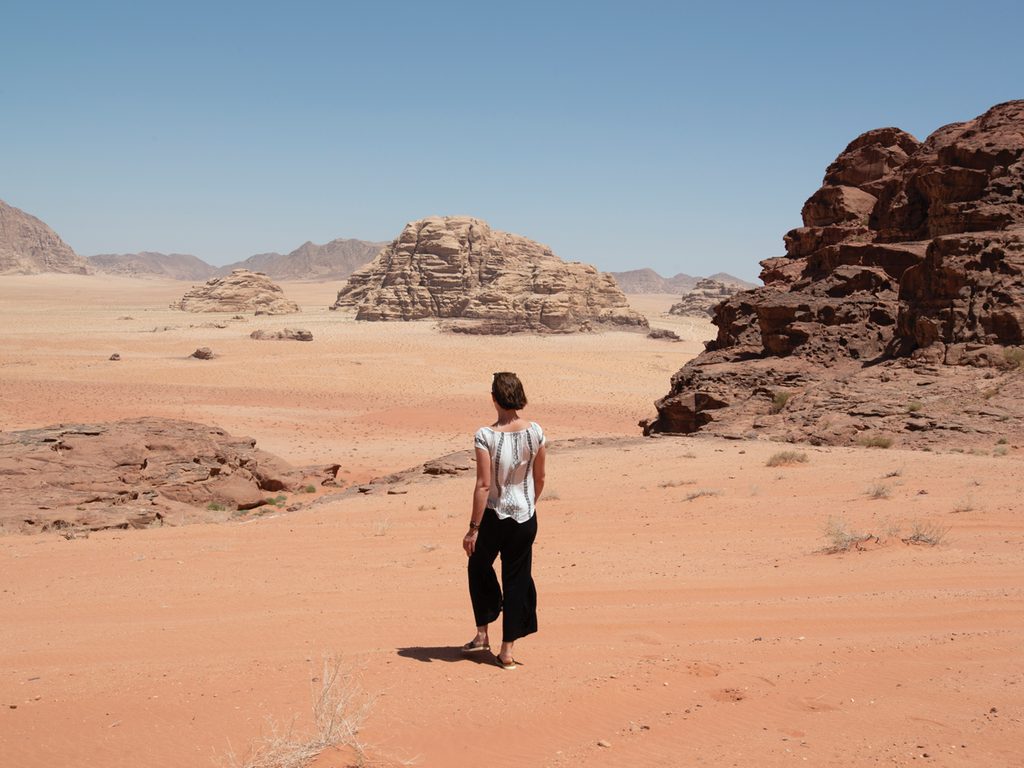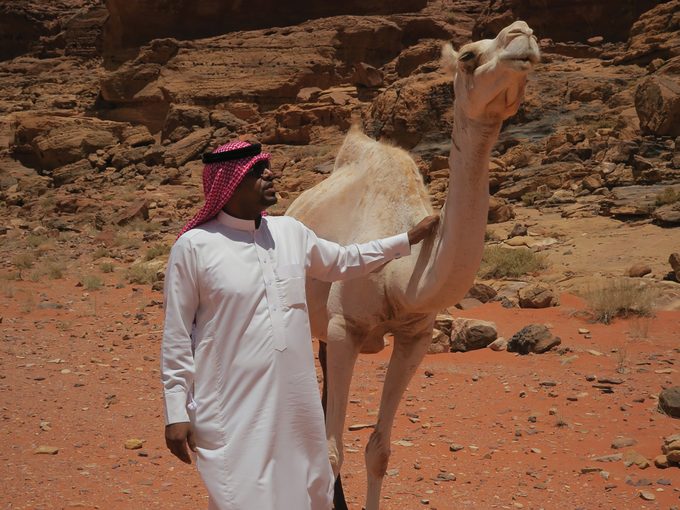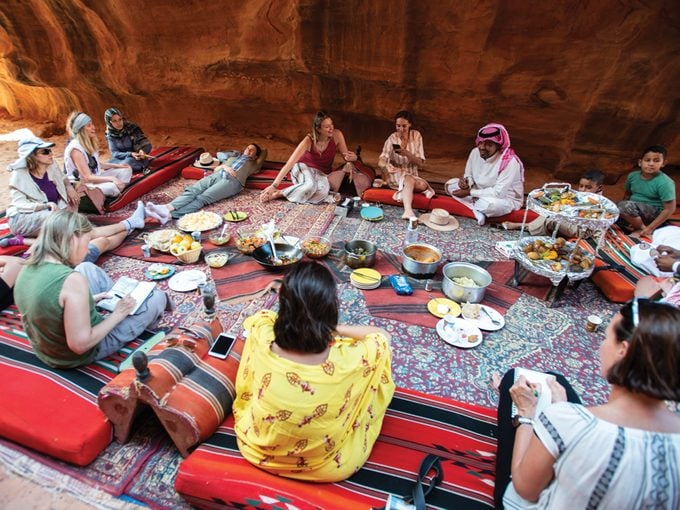How One Woman Found Herself—and Friends—Through Travel

A women-only travel company creates opportunities to explore the globe safely while forging genuine connections that might just change the world.
The magic didn’t happen when I leapt off the side of a sailboat to snorkel along a vibrant strip of coral near a quiet beach on the Red Sea. It didn’t happen on a sidewalk in Aqaba, where I feasted, family-style, with my travelling companions on fresh fish served on a bed of rice, accompanied by platters of warm pita and bowls of velvety hummus. It didn’t even happen when I rested my arms on the edge of an infinity pool and sipped a crisp mojito while gazing out across the Dead Sea (although, I have to admit, the preceding weightless soak in its salty waters, followed by a muscle-melting massage, was pretty amazing).
Blissful, unforgettable, bucket-list travel moments? Absolutely. But they weren’t the moments that defined my trip to Jordan. No, it was the desert of Wadi Rum that did it. And that is maybe the coolest thing about travelling: You never know when the true magic is going to happen for you. And so often, it has more to do with a person than it does with a place.
In this case, that person was Tyseer.
Tyseer is a once-nomadic Bedouin-poet-turned-desert-tour-guide. Resplendent in a long white thobe with a traditional red and white shemagh protecting his head from the sun, he shepherded us across the Jordanian desert in his battered white Nissan four-by-four, which fishtailed wildly through the sand – sideways over dunes – as he spun the wheel in time to the upbeat Arabic music blasting from the radio (his grin got wider with each barely muffled gasp from the back seat).

Before visiting Wadi Rum, which means “valley of the moon,” for me, “desert” was synonymous with sand, so the dramatic sculptural arches, red sandstone mountains, deep caverns and craggy rock faces that looked like the weathered cheeks of desert nomads came as a complete surprise. Otherworldly and mysterious, Wadi Rum is the perfect setting for space movies (The Martian, Star Wars’ Rogue One and Red Planet were all filmed here), and thousands of petroglyphs and inscriptions on its rust-coloured rocks are evidence of a human history that long predates its modern movie-star status.
Tyseer was born in this desert and moved to a small village at its edge when he was five. “I’m 30 now, and every day I still see something new in Wadi Rum,” he says. “The sand dunes move with the wind, and the shapes and light are always changing.” Humming popular love songs under his breath (there are 37 words for love in Arabic, he tells us) and calling to wandering camels (who come to him), Tyseer is often quietly introspective. The rest of the time, he is up to something.
En route to a traditional Bedouin lunch, he roared his truck up to a solid wall of rock and hopped out with an animated “Yallah, yallah” (“Come on, hurry up”), only to stop suddenly and feign dramatic disbelief. “Where is our lunch?” he cried, arms raised indignantly to the sky. “It was supposed to be here.” The grin reappeared as he led us under a secret, shadowy arch to where patterned rugs and pillows had been laid out on the sand.

After a meal of malfouf (stuffed cabbage rolls), shrak bread baked over a fire and zarb (a Bedouin barbecue buried and cooked over coals in a deep hole underground), Tyseer whisked us off again. He neglected to mention that we were on our way to climb the Burdah Rock Bridge, reputedly one of the highest natural arches in the world.
We balked at the bottom, but Tyseer “yallahed” us up the steep, narrow rock face. I couldn’t help but wonder if there’d be a fence, along with a sign of someone climbing up the rock with a red line across it, anywhere else in the world. Without Tyseer, who somehow convinced us that we weren’t in any danger, I never would have made it to the top of that arch, and I never would have been rewarded with a breathtaking, panoramic view of the crimson desert landscape bathed in soft, late-afternoon light.
And if it hadn’t been for Millie, a new women-only travel and lifestyle company, I never would have met Tyseer or experienced the true magic of Wadi Rum. Millie’s founder, Chelsea Brown, first travelled to Jordan in 2017 to support a Canadian initiative for Syrian refugees. She fell in love with the country and its people, and Millie is the result. Brown returned four times to create the foundation for our trip: luxurious hotels, charming restaurants and extraordinary adventures. (Learn how to maintain healthy sleep habits while travelling.)
Millie trips are more than just good travel stories.
“Millie was created to give women an opportunity to form genuine connections with communities around the world and foster self-discovery and kinship,” she says. “Our trips go beyond travel; they are about building lifelong friendships through meaningful experiences.” To that end, Brown cultivated relationships with the people we spent our days with, who added an extra layer of depth, meaning and magic to our time in Jordan. In Amman, we spent a morning immersed in a woodcarving lesson delivered by Syrian refugees who shared their stories and craftsmanship. At night, we dined al fresco in the company of Jordanian politicians and intellectuals in the walled garden of the former minister of tourism and antiquities.
We also explored Petra’s 2,000-year-old streets in the company of a local guide named Mahmoud. While other travellers jostled for selfie space at the base of the city’s magnificent Treasury – a feat of human ingenuity immortalized in sandstone – Mahmoud quietly led us up a path that is so seldom used, only he could see it (though it’s one he knows well, considering that he was born in one of the 850 caves carved into the ancient city’s cliffs). Standing at the top of one of those cliffs, we looked down at the bright, tasselled awnings of local merchants and watched a small camel caravan drift past a theatre that dates back to the first century AD. It was easy to imagine what the city must have looked like when it was home to the long-lost civilization of the Nabateans and caravans of 1,000 camels routinely passed through Petra, loaded with incense and spices.
These are the magical moments every traveller hopes for.
To have so many on one trip still fills me with gratitude for the people who helped make them happen. Back in Wadi Rum, before we retired to enjoy the night sky through our clear-ceilinged bubble tents, we collected brush from the spiky bushes that dot the desert so that we could build a fire for our tea and watch the sun set over the mountains. Tyseer told me he loves the mountains because they give without taking. “They bring the rain and protect us from the winds,” he says. “The greatest compliment you can give a friend is to say they’re like a mountain.”
While we waited for the first stars to appear, I sat next to Ghada Saba, one of those so-called “mountains.” She is Jordan’s first female film director and founded an NGO to help abolish forced marriages. (A tattoo on her right arm translates to “Don’t get angry; get mad.”) We talked quietly about Canada and Jordan, marvelling at our similarities and celebrating our differences. “There’s a strong connection between Jordanian and Canadian women,” she told me. “We’re the same. We have similar values, and it’s important for Canadian women to come here to experience that. Travel helps us to understand one another better so that we can do great things together.” And therein lies the magic.
Next, learn why Palm Springs is the ultimate wellness getaway.




